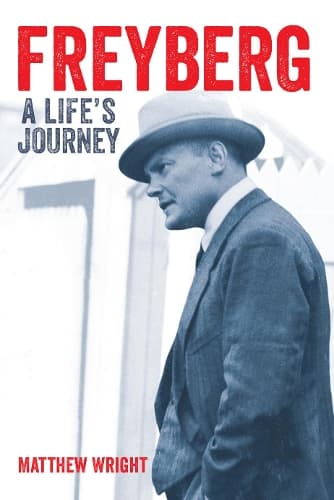Freyberg: A Life’s Journey
Reviewed by David Littlewood
Writing a book about Bernard Freyberg that is deliberately ‘not a military history’ might appear counterintuitive. After all, Freyberg’s public profile largely revolves around winning the Victoria Cross for bravery during World War I and commanding the Second New Zealand Expeditionary Force between 1940 and 1945. Yet as Matthew Wright demonstrates during this impressive new biography, adopting a broader perspective helps us to better understand Freyberg’s battlefield conduct and decisions as well as providing important insights into post-1945 New Zealand society.
Wright presents Freyberg’s life as a ‘journey’ in both the geographical and the personal sense. Each of the 15 chapters is based around a significant experience that either developed a new character trait or demonstrated the enduring influence of existing ones. While several of these experiences are widely written about – particularly Freyberg’s generalship on Crete and in the North African desert – Wright also devotes considerable attention to his upbringing in Wellington, his unhappy pursuit of a career in dentistry, his murky involvement in the Mexican Civil War, his inter-war hiatus in London, and his stint as Governor-General of New Zealand.
On first meeting Freyberg, many people came away believing he was naïve, painfully slow to reach decisions and of an innocent – even ‘child-like’ – demeanour. By examining the key moments of his life, Wright convincingly overturns these limited impressions to reveal a complex and layered individual. Freyberg’s approach to problems did not derive from a lack of intelligence but from a desire to consider multiple possibilities, often with input from his trusted advisors, before reaching a final verdict. Far from being an unthinking or unfeeling ‘action-hero’, he was a man of great empathy and compassion who was deeply affected by the death of those close to him.
Wright also demonstrates why Freyberg was so popular with his men and why he made so many life-long friends. Despite his battlefield exploits and meteoric rise up the military hierarchy during WWI, he remained grounded and avoided trading on his reputation or status. As a commander, he downplayed some of the more formal aspects of military life in favour of developing a strong relationship with his soldiers – placing great emphasis on their morale and well-being, taking part in sports fixtures and cultivating a relaxed and collegial atmosphere among his headquarters staff.
These interactions were to have an enduring significance. With such a high proportion of New Zealand men serving under Freyberg’s command during WWII, and with several of them going on to hold major political, social or cultural positions, Freyberg’s values and characteristics were to play an important role in shaping post-1945 New Zealand society.
There are a couple of issues. One revolves around occasional lack of detail, such as being told the circumstances under which Freyberg’s 1940 ‘Charter’ – which defined his relationship with the New Zealand Government and the New Zealanders’ position within the British Army – was written, but not how it evolved from draft to draft or exactly what the final version contained. Another is how Wright sometimes pairs his nuanced portrayal of Freyberg with an uncritical acceptance of wider myths – all WWI soldiers came back disillusioned and dislocated from society; ‘nobody’ in the British army took blitzkrieg methods seriously before 1940.
Yet these are minor quibbles with a book that is important, accessible and beautifully produced. It might not be a ‘military history’ in the conventional sense but it sheds important new light on Freyberg the general as well as on Freyberg the man.
Reviewed by Dr David Littlewood
